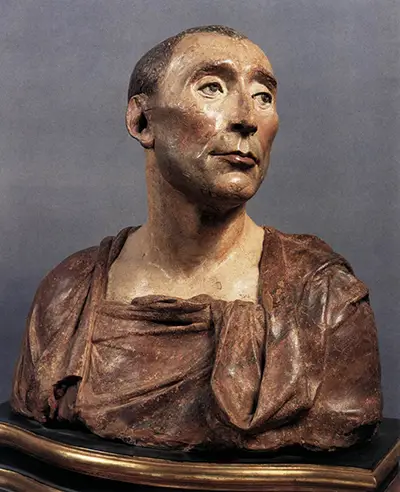Donatello completed the bust of Niccolo da Uzzano, after the statesman had died, in 1431
This work by Donatello is a step away from some of his large and grand sculptures. It is a great masterpiece of art and sculpture, although smaller than most of his other commissions; and both dramatic and lifelike.
The lines and fluid features of the sculpture show that Donatello had an understanding of the man in the sculpting of this piece. Donatello must have either known him, or had heard a great deal about Niccola da Uzzano, to have produced a bust that emphasised the apparently mild-mannered, yet strong and noble leader that this bust depicts.
Who is Niccolo da Uzzano?
Niccolo da Uzzano - was one of nine people voted to form a government in Florence. As the Gonfaloniere of Justice — he was an important man. In Florence, he was a standard-bearer for the Republic of Florence, and the city's banner was in his care.
He was in charge of the city's justice department, which kept public order and also looked after the internal security of the city. He was an influential and important statesman in Florence. As a statesman in Florence he held power and he would have been accustomed to giving orders.
What did Donatello see in Niccolo da Uzzano?
With the bust of Niccolo da Uzzano, Donatello gave the subject a realistic and natural movement, sideways, of the head, neck and eyes that makes the bust appear lifelike. The expression appears mild but firm at the same time. There is almost a partial smile on the face of Niccolo da Uzzano and, at the same time, the face is one of a leader that will be followed.
So, Donatello depicted a man that could command attention and give orders without appearing aggressive. He gave the bust clothing that was imperial, and anciently decorated, and gave the subject an expression of someone used to his own power. This appearance of power shows in every angle of the bust.
How Donatello Depicted this Influential Man
With the bust of Niccolo da Uzzano, Donatello portrayed a movement of the head, neck and eyes which put the work into three dimensions instead of two. The three dimensional aspect, when looking at the bust from any angle, depicts movement and appears to give the work some fluidity. This is not just a still-life portrait in sculpture, it is a moving and vital piece of work.
Donatello uses terracotta clay for this bust, and uses deep colouring to the clothing, features and hair. He uses the flex of the neck and head to show someone in authority who is used to giving orders. The sculpture is very life-like and has been given more reality due to this angled movement of the subject. Instead of depicting an idealistic and traditional two-dimensional portrait of the man, Donatello managed to raise him up to his stature as a public figure using a lifelike sculpture with an appearance of natural movement.
Donatello uses the ancient style of terracotta and embellishing with deep colours to accentuate the status of this subject. The robes are accentuated with deep colour and the lines of the robes are pronounced. The bust is obviously of someone in high office; which Niccolo da Uzzano was. The style of sculpting with terracotta clay and deep colouring for decoration is ancient in design, but the difference with Donatello's work is the angle of the head, neck and eyes which gives the sculpture an effect of live movement.
This live movement appears to be of someone who gives orders rather than receives them. Donatello, at the time of this commission, was an accomplished artist and sculptor. He had his own style of portraying his artistic works. Donatello gave movement and life to his sculptures. His work portrayed movement and the subjects of his work were not just portraits.
The bust of Niccolo da Uzzano shows him to be an influential leader and depicts his status as Gonfaloniere of Justice. Donatello brings him to life as a leader with authority and grace. A very true likeness for a leader of the justice department of the Florence government, and a likeness that doesn't underestimate that position.
Donatello has applied all the artistic devices to imply the pomp and ceremony of the role Niccolo da Uzzano had. In giving this piece of sculpture a lifelike movement , Donatello has given the man a realistic pose that also implies his position of power in life. This is a realistic and active portrayal with sculpture in three dimensions.




